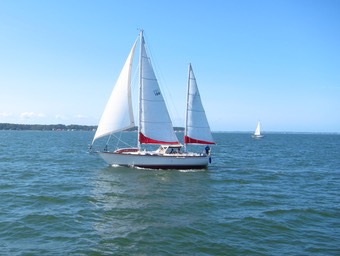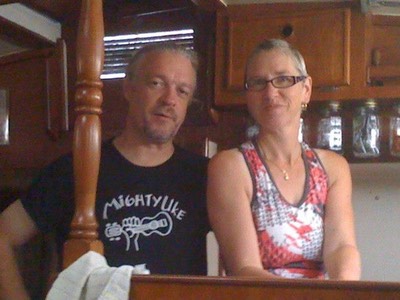Travel 2017-2018
Some Firsts
The West River Sailing Club Autumnal Equinox cruise involved a number of firsts for Red Ranger. It’s difficult to count the number of firsts we enjoyed.
The first of the firsts was visiting Harrison Creek and Dun Cove. This is about two miles north of Knapp’s Narrows. It’s quiet, and secluded. We’re grateful for the recommendation as a cruising destination. We’ll be back.

Rather than move Red Ranger nearer to town, we took the dinghy down to Knapp’s Narrows and the village of Tilghman. Two miles by dinghy in flat conditions was fun. If the wind had picked up, this would have been a long, wet mess.
This was our first visit to Tilghman and it was a delight. Lunch at Marker Five was excellent, and the price for fuel on the other side of the narrows made the dinghy ride even more valuable.
The town is (of course) cute. It’s also microscopic. We saw two restaurants — Characters and Marker Five — a small marina, some commercial wharves for the watermen, and a gas station. The buildings seem to be a mixture of newer vacation homes and older, traditional houses. We didn’t look very hard, and we’re certainly going back to take a more thorough survey.

The Kronsberg Park Tower wasn't our fist mysterious structure. It was, however, our first mystery on Tilghman Island.
We had a number of theories to explain this structure. All were proven wrong when we finally checked WBOC’s web site for information on the tower. The mystery is much more exciting than the reality.
Hint. Note the four doors on the side of the tower. They have knobs. And they have hooks so they can be held open.
And yet.
There are no steps or platforms. Weird, right? What kind of giant can use the top 7' tall door that’s almost 21’ off the ground?
And no, I won’t reveal the mystery here.
One of Red Ranger’s sailing firsts was to sail off the anchor. We watched another boat hoist their mains’l while at anchor, haul in the anchor, and sail away. Because the cove is large, and there were few boats, and only 6-8 knots of breeze, we decided to try this, also.
We have a mizzen, which makes it very easy to turn her and sail away from the anchorage. Pushing the mizzen rotates the boat. She’s remarkably responsive to the twisting moment of this sail. The gentle drift generated by the mizzen is only about one knot in six knots of wind. I think this is too slow for the rudder to have much impact on direction. The mizzen, however, steers nicely.
CA’s personal first was nabbing four mylar balloons in the Bay on the trip back.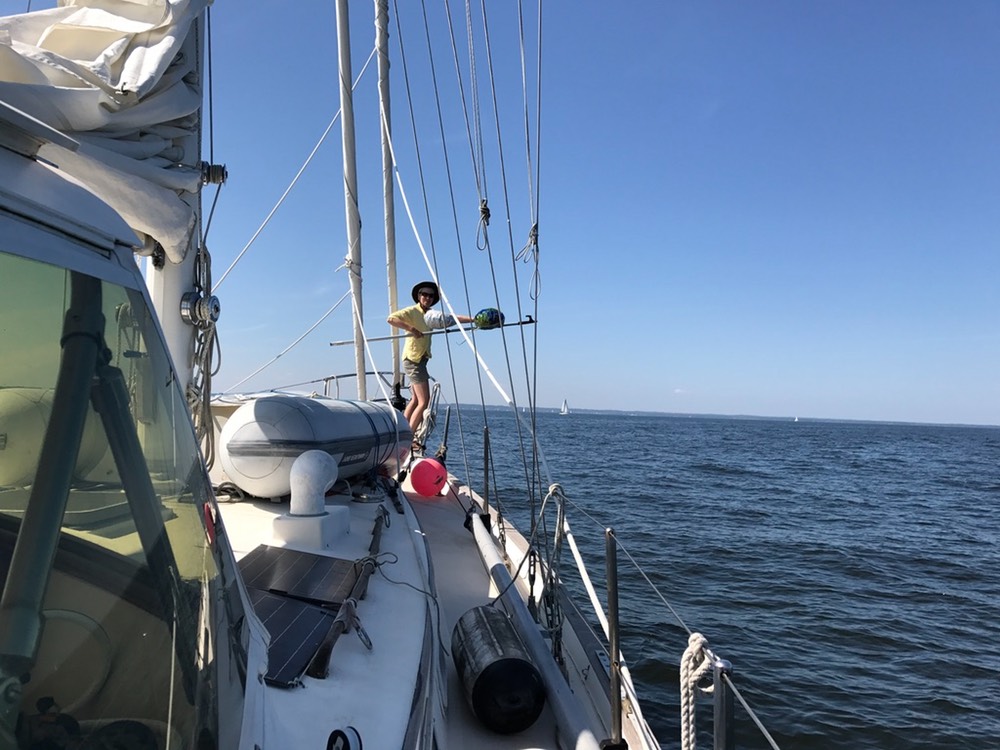
We treat balloons in the water as an MOB drill. We have a passionate dislike for balloons released into the wild. Plastics in general cause a great deal of harm, and balloons in particular are dangerous to the Bay. Here’s an article from the U. S. Fish and Wildlife Service on balloons and wildlife.
Another important Red Ranger first was raising the main. This does sound a little crazy. It’s true that ketches handle well under heads'l and mizzen: we call it the the jib and jigger rig. I’m talking about something else on this trip. For the past eight years, we’ve used the engine to hold Red Ranger into the wind when raising the main. We’ve read about using the mizzen for this, but never actually tried it before. With light breezes and plenty of room to maneuver in the Choptank, it turns out that the mizzen does better at steering into the wind than CA does.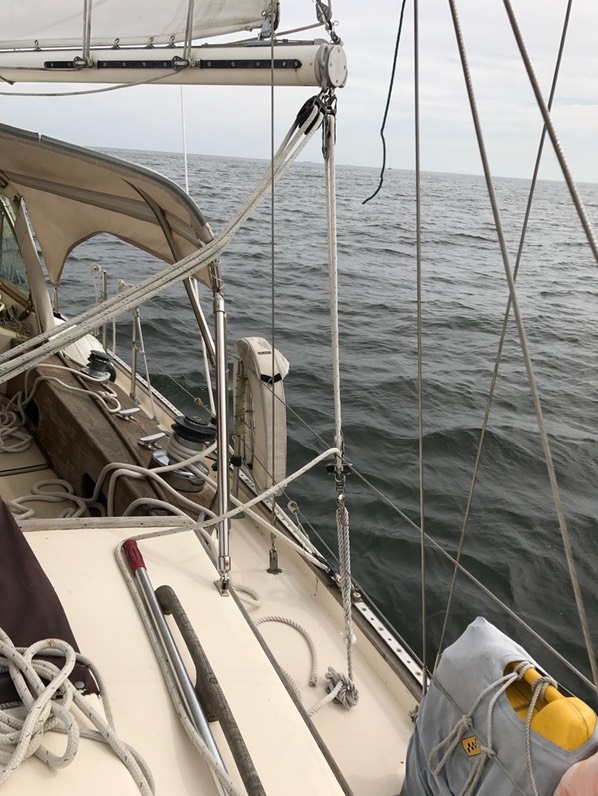
We also tried another experiment on Red Ranger. We invented the “shabby traveler.” The Whitby was not designed for a conventional square bimini covering the whole cockpit. The main sheet’s anchor point requires a semi-circular bimini.
Many boats have travelers, but Whitbys have an aft cabin hatch, and the traveler would block access. A removable traveler is an expensive option.
We have a cleat that’s more-or-less under the boom. I think it was intended for handling the running backstays. Our boom vang is a removable four-part block and tackle that can be used to pull the middle of the boom down to the toe rail. Or. It can be used at the end of the boom on the cleat. With a big snap shackle, the main sheet can be removed, eliminating pressure (and chafe) on the bimini when running downwind.
Of course, gybing is complicated. Need I say more? It’s a challenge on any big boat.
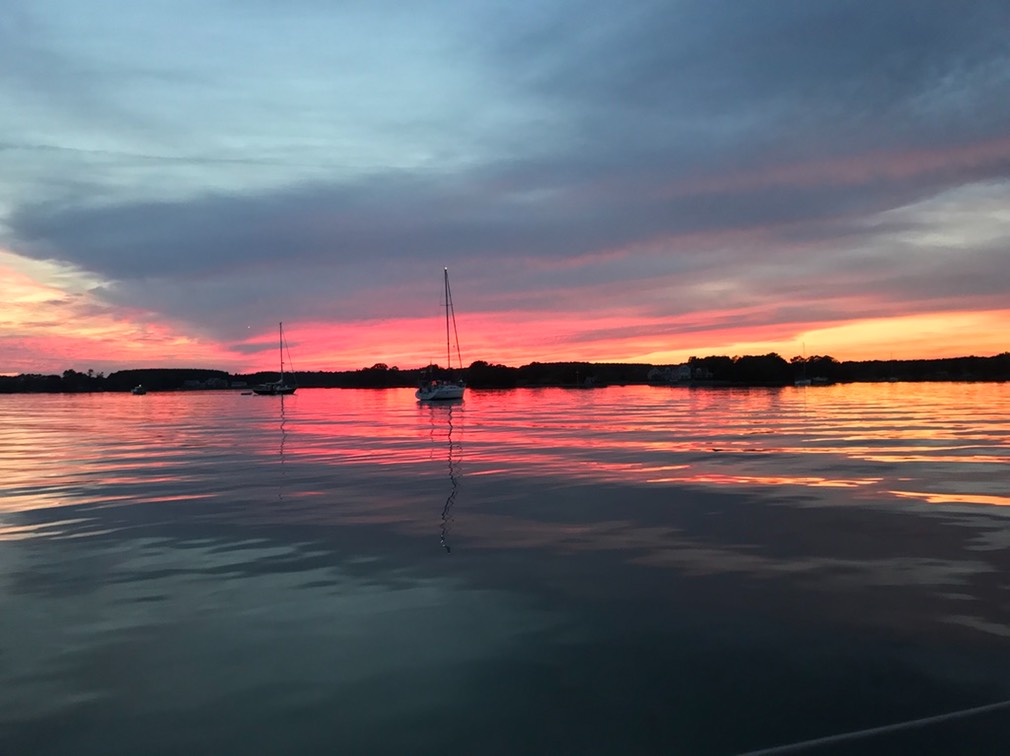
Sunset on the Dun Cove on the 2017 equinox.
Anchor Locker, Ground Tackle, and Silt
The bottom of the Chesapeake involves silt. A lot of it. Anchoring in silt is kind of fun. You barely have to think about it. Except, of course, for the silt that stays with your anchor chain.
When we first started sailing down here, we heard an old salt explain anchoring in the Chesapeake.

“Y’all are doin' it wrong: you cain’t back down under pow’r: you’ll just dig a furrow in the silt. To anchor in the Bay, you drop the hook. Then you take your first beer. Then you may back down under pow'r to test the set.”
“Take your first beer” he said.
The other end of this operation is hauling the chain back in. In most cases, the chain links themselves are holding the boat in place. The 25 kg chunk of steel is just insurance.
Our locker has about 100′ of ⅜ HT chain, another 150′ of rope that’s the primary rode. On the other side is another 150′ of rope with maybe 20′ of chain that is our first backup.
We have a second backup. Really.
The red ball is a float that use us to help understand exactly where the anchor is.
If we’ve been anywhere for more than a few hours, the chain will be caked with silt. A tube of mud. We have a nice wash-down system, and CA can hose the chain clean as it comes in.

But, of course, it’s not clean. It’s mostly in a “reduced mud” state. After being hosed off, it has somewhat less mud than it come up with. But it’s not zero mud. The mud accumulates in the anchor locker because the locker has one drain, and we don’t keep the chain near that drain.
It’s hard to see, but through the little door is a white patch of hull with a brown, wood divider. The port side of the locker has a drain. The starboard side?
No drain.
So mud tends to accumulate. How much mud?
This weekend we took out all the chain to give it a good fresh-water rinse.

You can see About ⅝” of mud in this picture. There’s a metal probe on the end of the calipers for measuring depths.
Yes. That’s a pretty big pile of mud. It never dries out. And. The chain sits in it. Rusting.
We drilled drain holes so that the muddy water could run down into the hull and — eventually — wind up in the deep bilge. It does mean that once a year we have to take a hose and run water into the anchor locker, under the floors, chasing the mud and silt back to the deep bilge.
We pump as much of it out with a hand pump as we can. Then wait for the sand to dry out, and shop-vac up the left-overs.
Okay. So the fun of anchoring in silt ends when it’s time to hose out the hull. But until the annual hull and ground-tackle washing, it's a lot of worry-free fun.
Happy Birthday Sail

Overnight in the Rhode River.
Here’s where we anchored.
There’s a big open creek with a bunch of low islands. Very salt-marsh. Many other boats because it’s very pretty and accessible.
It’s a few hours south of Annapolis. A few hours north of Herrington Harbour.
Here’s something we saw in the bay.

That’s some classic schooner. It’s hard to tell from the picture, but it’s maybe 47′ or 50′ in length.
Often, schooners that are still working are 80′ or over. The Spirit of Virginia in Norfolk is big.
This was small enough that it didn’t require a big professional crew to raise and lower the heavy gaff-rigged sails.
Interestingly (to me) she was slow. We blasted by her wondering why she wasn’t moving. That’s an odd thing to feel in Red Ranger. We have a ploddingly slow boat. We know that and actually kind of like it.
When it was blowing 12 to 15, we made 6 knots and were happy. We might have been able to squeeze 7 knots of out her, but that means a steeper angle of heel and pulling out the mainsail. I don’t like to spill the olives from my martini, so we try to avoid heeling.
As the wind died, so did our speed. When we crossed paths with the schooner, we were barely doing 4 knots. We really should have shaken out the mains'l. But. We were on our final tack into Herring Bay and there was no reason for any more speed.
Dog-Stopping
The West River Sailing Club Labor Day cruise involved a parade of rain showers on Saturday, leaving a lot boats on the dock. We ventured out Friday and learned a new word: “dog-stopping.”
The cruise had two destinations. We’d been told about La Trappe creek. “Lovely,” “Quiet.” Those sorts of things. But we’d never been there before. This was our plan, lead a cruise to a place we’ve never seen.
We lived aboard Red Ranger for two years. We visited a lot of spots with no more preparation than a recommendation in an out-of-date ICW guide book. We ran aground in a few places. I blame the tides in North Florida for most — but not all — of my groundings.
As with many places on the Chesapeake, the understatements on the charts are hilarious. Our favorite understatement is the Reedville stack. The chart says “Stack.” It should say “STACK!!!” The Reedville stack is an immense, hard-to-believe thing.
The entrance to La Trappe creek has a prosaic little 'Fl G 4s 21ft 4M “1”’ As of it’s just a simple red day board. The only hint of the insanity is the little “21 ft”.
This turned into one of those “No you give me the binocular” situations.
There’s a bend in the Choptank around a shoal that’s charted at 15 feet; irrelevant for our boat. But. Of course, you never really know. Other boats are cutting inside red “18” and red “18A”. When we spotted the La Trappe green “1”, the concern about the exact depth inside the reds evaporated into a fight over what we’re really seeing there.

There are two huge boilers standing on rock piles with day boards to mark the entrance. The cartographers really need something other than a little magenta splash or a little circle with a dot.
We have detailed bathymetric views on our chart plotter, so we could find the 10’ deep channel without any difficulty. It’s surprisingly close to the red, but otherwise easy to follow.
Saturday was knitting day. CA and Diane had brought their knitting. We had Cokie Roberts' Ladies of Liberty on the audio book reader, and plenty of coffee. The creek is beautiful. But it was cold and rainy. And someone forgot their wooly socks.

Sunday, the weather was a delight. The wind was out of the NW falling from 10-ish to 5-ish through the afternoon. We moved Red Ranger to Plaindealing creek, across the Tred Avon from Oxford. This is quiet and secure. We’ve been here before, and we like anchoring close to the mouth of the creek.
We launched the dinghy and darted across the river to visit Oxford. This was our first visit, and we oohed and aahed over everything.

In the afternoon, Hot Chocolate checked in when they started across the bay. Later we heard they were dog-stopping in Oxford. When we met Dupree — wearing his collar of shame — it became clear what Dog Stopping meant: tie Hot Chocolate off at the T-head by the ferry terminal, take Dupree around the park for his stop, and then back out to anchor.
Monday, the winds started at a pleasant 10 knots, blowing from the west. Since we had guests to meet, we left Plaindealing creek at 8:00 AM. With wind on the nose, we motored down the Choptank. Out in the Bay, the wind had backed into the SW, and was fair for sailing back to Herring Bay. Since the wind was dropping and we had a schedule, we motored.
We learned a number of useful lessons. First, we need to watch out for double-booking our weekends. We missed sailing Monday morning because we had a schedule. Second, we need to be sure our hors d’oeuvres are scalable from one boat to many boats. Cindy Ann has an idea for multi-part hors d’oeuvres. I’m hoping for some test-flights. Third, I realized that while it’s still technically summer, the nights can be chilly and my fleece socks need to be kept on the boat.
Finally, we learned what “dog stopping” is. We enjoyed Oxford, and we’ll need to do more dog stopping there on future cruises.
